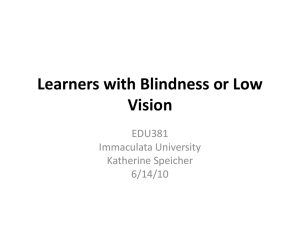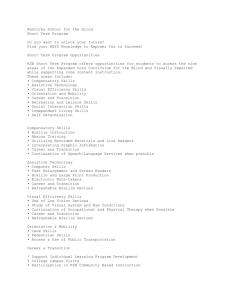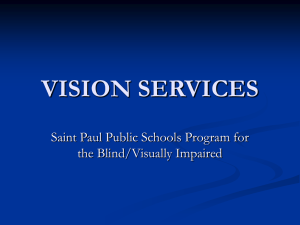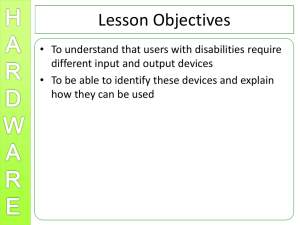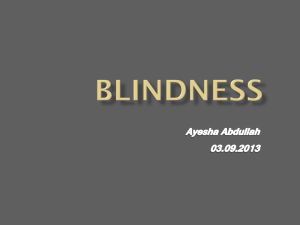Senate Inquiry into Students with Disability – August 2015
advertisement
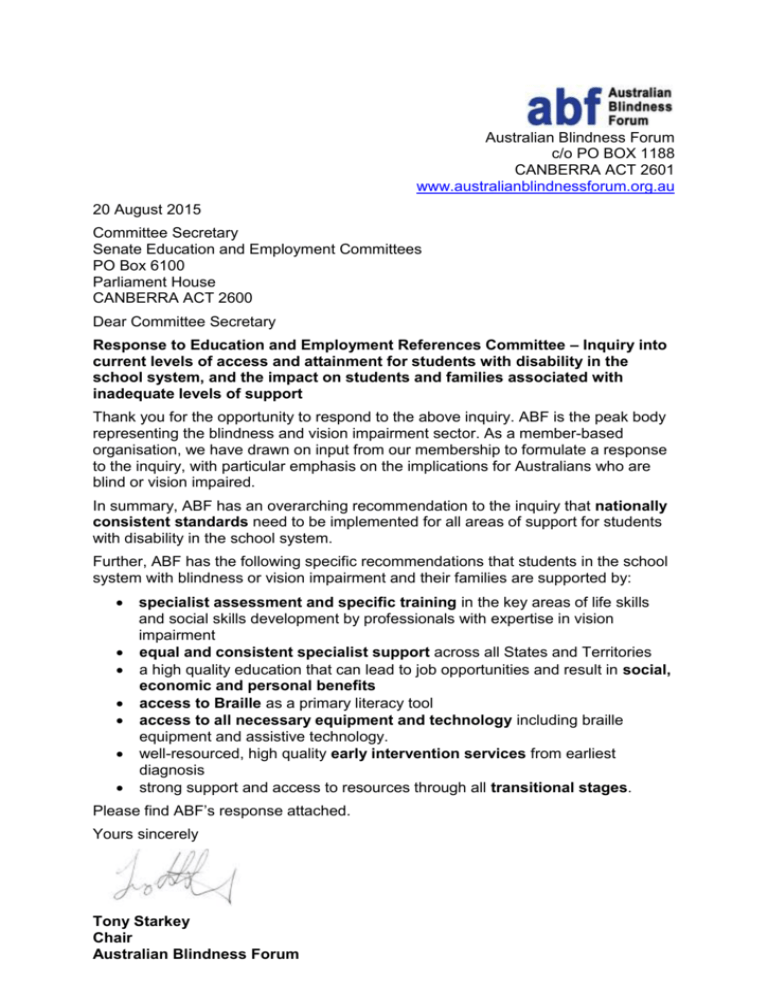
Australian Blindness Forum c/o PO BOX 1188 CANBERRA ACT 2601 www.australianblindnessforum.org.au 20 August 2015 Committee Secretary Senate Education and Employment Committees PO Box 6100 Parliament House CANBERRA ACT 2600 Dear Committee Secretary Response to Education and Employment References Committee – Inquiry into current levels of access and attainment for students with disability in the school system, and the impact on students and families associated with inadequate levels of support Thank you for the opportunity to respond to the above inquiry. ABF is the peak body representing the blindness and vision impairment sector. As a member-based organisation, we have drawn on input from our membership to formulate a response to the inquiry, with particular emphasis on the implications for Australians who are blind or vision impaired. In summary, ABF has an overarching recommendation to the inquiry that nationally consistent standards need to be implemented for all areas of support for students with disability in the school system. Further, ABF has the following specific recommendations that students in the school system with blindness or vision impairment and their families are supported by: specialist assessment and specific training in the key areas of life skills and social skills development by professionals with expertise in vision impairment equal and consistent specialist support across all States and Territories a high quality education that can lead to job opportunities and result in social, economic and personal benefits access to Braille as a primary literacy tool access to all necessary equipment and technology including braille equipment and assistive technology. well-resourced, high quality early intervention services from earliest diagnosis strong support and access to resources through all transitional stages. Please find ABF’s response attached. Yours sincerely Tony Starkey Chair Australian Blindness Forum ABF response to: Education and Employment References Committee: Inquiry into current levels of access and attainment for students with disability in the school system, and the impact on students and families associated with inadequate levels of support About the Australian Blindness Forum The Australian Blindness Forum (ABF) was formed in 1992 and is funded only by its members. ABF is an Australian public company limited by guarantee and governed by a Board of Directors. ABF is the peak body representing blindness, low vision and rehabilitation in the blindness sector. Membership of ABF is open to any organisation that has as its primary objects the provision of services to people who are blind or vision impaired, or whose activities are substantially connected with the welfare of people who are blind or vision impaired, and those whose activities are substantially related to the prevention of blindness. ABF combines the voice of people who are blind or vision impaired with that of the specialist service providers across the sector. ABF is represented in every state and territory of Australia and all major organisations providing services to Australians who are blind or vision impaired are members of ABF. ABF comprises 17 blindness sector service providers whose expertise and knowledge is reflected in the following comments. Response to terms of reference ABF strongly supports the view that every person in Australia has the fundamental right to live as independently as possible within the community. For children or young people with blindness or vision impairment, adequate preparation of the child to thrive during the key transition stages – such as starting kindergarten, commencing primary school or entering high school – is critical. This ensures the necessary skills and competencies are in place to allow the individual to function independently as far as possible during each phase of their juvenile development. This necessitates children receiving quality, comprehensive and coherent education and training to develop their skills across all areas including orientation and mobility; independent living; social skills; Braille literacy; leisure, sport and recreation skills; assistive technology; vocation and job seeking skills; and efficiency with remaining vision. ABF has an overarching concern with the lack of nationally consistent standards for the education of children who are blind or vision impaired. This lack of 2 Australian Blindness Forum, c/o PO Box 1188, Canberra, ACT 2601, www.australianblindnessforum.org.au consistency affects all areas of support for students with blindness and vision impairment in the school system. For example, definitions for access to Braille, specialist support and provision of aids and technology vary between states and between the government and independent sectors. All points made in this submission below are underscored by the urgent need for nationally consistent standards for all areas of support for students with disability in the school system. Term of reference a current levels of access and attainment for students with disability in the school system, and the impact on students and families associated with inadequate levels of support Specialist support National and international experience and research demonstrates that a child who is blind or vision impaired must have specialist assessment and specific training in the key areas of life skills and social skills development if they are to achieve an optimum level of independence. The skills and knowledge that sighted students acquire by casually and incidentally observing and interacting with their environment are often difficult, if not impossible, for students who are blind to learn without direct, sequential instruction by professionals with expertise in vision impairment. These skills include social interaction skills, Braille skills, and orientation and mobility skills. Generic special education teachers do not have the specialist skills required to teach these skills to children and young people with blindness and vision impairment. Without access to specialist support and training, children with blindness or vision impairment will have limited participation in all aspects of school life. Therefore, it is important to retain specialist qualifications in teaching children with blindness and vision impairment. A range of quality specialist training must be available for professional preparation and for ongoing professional development. Educational agencies must be committed to employing and/or training personnel with appropriate qualifications in teaching children with blindness or vision impairment. The types of specific specialist supports include orientation and mobility skills training, access to visiting teachers and classroom adjustments from a specialist allied health professional. Adequate staff/child ratios are also essential to ensure quality service provision. Equal and consistent support Resource provision for the interactions between educational establishments and organisations providing services to children who are blind or vision impaired and their families in each State or Territory is inconsistent and, in some cases, lacking. In particular, due to the variation in access to specialist support as a result of different responses to disability resources across each State and Territory, specialist intervention can be inequitable and inadequate in quality, scope and outcomes. As a result, many young people with vision impairment are leaving the compulsory school system inadequately prepared for post-school options or to live independently. Equal and consistent support must be provided, regardless of where a child lives. A national approach that addresses the timely delivery of education including life skills 3 Australian Blindness Forum, c/o PO Box 1188, Canberra, ACT 2601, www.australianblindnessforum.org.au development from early childhood through the growing years would provide muchimproved outcomes for students who are blind or vision impaired and their families. Term of reference b: the social, economic and personal benefits of improving outcomes for students with disability at school and in further education and employment Despite the introduction of the Commonwealth’s Disability Standards for Education (2005)1 and collaborative efforts of educators to develop principles and standards for the education of children who are blind or vision impaired2, many young people with vision impairment are leaving the compulsory school system inadequately prepared to take on further study, seek employment, participate meaningfully in the community, and live independently. The unemployment rate for adults with blindness or vision impairment is very high, much higher than the average unemployment rate across Australia. A report by Vision Australia on employment levels of people with blindness or vision impairment3 found that in 2012 58% of the 600 respondents surveyed were unemployed not by their own choice people who are blind or have low vision who want a job are four times more likely to be unemployed compared to the general population three quarters of respondents with a tertiary qualification were employed showing the strong impact of education in enhancing job opportunities. The current unemployment rate of the general population is 6.1%4. These figures show the high level of unemployment for people with blindness or vision impairment compared with the general population and the link between a tertiary qualification and better job opportunities. This highlights the importance of a high quality education that encompasses all the necessary resources, support and skills in order for students with blindness and vision impairment to be able to ultimately achieve a level of education and employment commensurate with the general population. Improving outcomes for students with blindness and vision impairment at school will result in social, economic and personal benefits to those students through attainment of an education that can lead to employment and an independent and more fulfilling life. Term of reference h: what should be done to better support students with disability in our schools Access to Braille Students with blindness or vision impairment need to have access to Braille as a primary literacy tool. This involves the students learning Braille from teachers who 1 Department of Education and Training, https://education.gov.au/disability-standards-education SPEVI (South Pacific Educators in Vision Impairment), http://www.spevi.net/about-us-2/principles-and-standards/ 3 Research and Measures Team – Vision Australia (2012), "Employment Research Survey Report 2012" – International and Stakeholder Relations Department. 4 Australian Bureau of Statistics, July 2015, http://www.abs.gov.au/ausstats/abs@.nsf/mf/6202.0 2 4 Australian Blindness Forum, c/o PO Box 1188, Canberra, ACT 2601, www.australianblindnessforum.org.au have the appropriate training and can provide ongoing support to the student and the student’s family as part of the Expanded Core Curriculum program for students with vision impairments. Access to braille skills development, braille reading and writing tools, and braille materials is the right of all children and adults who are blind or vision impaired and is integral to maximising opportunities for their participation in all aspects of life. This includes childhood development, education, employment, leisure and recreation, homemaking, personal care, and information management. Students who are blind or vision impaired must have: sufficient opportunities to develop braille competency convenient and affordable access to equipment that is used for reading, writing, and the personal production of braille equitable access to information in braille that is available to the general community in print formats. Development and maintenance of these skills is particularly important for children born blind or with vision impairment, given that the development of competency in literacy and numeracy is fundamental to a child’s education. Braille skills training is also important for those students whose vision is likely to deteriorate in the future in order to increase the options available to them as they progress with their studies. Equipment and technology Students with blindness or vision impairment need to have access to all necessary equipment and technology including assistive technology. Students also require appropriate training in the use of such equipment by teachers and educators with expertise and qualifications in vision impairment. It is imperative that such equipment and technology is not only provided in the classroom environment but is available for students to take and use at home. Taking equipment home is becoming commonplace for all students in the education system, particularly with the introduction of the use of laptops and devices such as iPads and tablets as integral parts of the curriculum. In addition, all online benchmarking tools need to be developed in an accessible form to allow equal access to braille users, synthetic speech and large print. Braille equipment As stated above, the facility to read and write braille on paper is, and will remain, fundamental to the development of basic literacy and numeracy for people who are blind or vision impaired, just as print-on-paper remains the basis for literacy in the general community. Children who are blind or vision impaired must therefore have convenient and affordable access to braille reading and writing tools including braille paper and basic writing equipment. Braille equipment is available to provide access to digital technologies such as computers, and in order to participate fully in all aspects of life, people who are braille users must also have convenient and affordable access to electronic braille equipment such as refreshable braille displays and braille note-taking devices. 5 Australian Blindness Forum, c/o PO Box 1188, Canberra, ACT 2601, www.australianblindnessforum.org.au Assistive technology Assistive technology is essential throughout infancy, childhood and adolescence so that children who are blind or vision impaired are able to keep pace functionally, socially, and academically with their sighted peers. Assistive technology used by these students includes braille displays, hand magnifiers, telescopes, CCTVs, screen reading software and voice output devices. Assistive technology must be available in the home from the earliest possible stage so that children who are blind or vision impaired have access to equipment that will support age appropriate development and participation in the typical routines of the home. Current state-based provision of assistive technology to children who are blind or vision impaired is ad hoc and inequitable. Families of children who are blind or vision impaired who move from one state to another are forced to be reassessed (often an extensive process with strict timelines and conditions) because assessment for equipment is not accepted across state borders. Equipment and aids must be in place before the child approaches key transition points of childhood and adolescence, for example, transitioning to playgroup, to kindergarten, to primary school, to high school, to college, to tertiary study and to work. Children who are blind or vision impaired also need access to assistive technology for use in the community to participate in social, leisure and recreation activities in age appropriate ways with their sighted peers. Inadequate access to vital assistive technologies will compound the social and functional disadvantage caused by blindness and vision impairment. Term of reference i: the early education of children with disability Early intervention It is critical that all children with blindness or low vision and their families have access to well-resourced, high quality early intervention services from the earliest point of diagnosis. Families need to be provided with access to appropriate information, resources, support and training to enable and empower them to promote the best possible outcomes for their children. This is particularly important at the pre-school level where families are just entering the school system. Inadequate early intervention services can have a significant adverse impact on a child’s future education and prospects later in life. Transitional stages Students needs to receive strong support and access to resources throughout all transitional stages of their education. This would enable a successful transition from pre-school to primary school, primary school to high school, high school to college and on to university. It is critical that students who are blind or vision impaired have adequate support in vocational counselling, ensuring that they have options and choices not limited by their vision impairment. As stated above, equipment and aids, such as Braille equipment and assistive technology, must be in place with the appropriate access and training as early as possible and before the child approaches key transition points of childhood. This 6 Australian Blindness Forum, c/o PO Box 1188, Canberra, ACT 2601, www.australianblindnessforum.org.au includes during a child’s early education such as transitioning to playgroup, to kindergarten/pre-school and to primary school. Conclusion As stated above ABF has an overarching concern with the lack of nationally consistent standards for the education of children who are blind or vision impaired. All recommendations made in this submission are underscored by the urgent need for nationally consistent standards for all areas of support for students with disability in the school system. 7 Australian Blindness Forum, c/o PO Box 1188, Canberra, ACT 2601, www.australianblindnessforum.org.au

